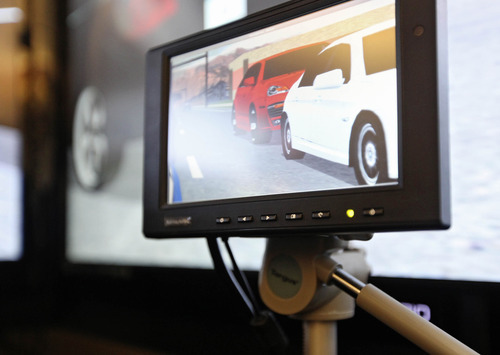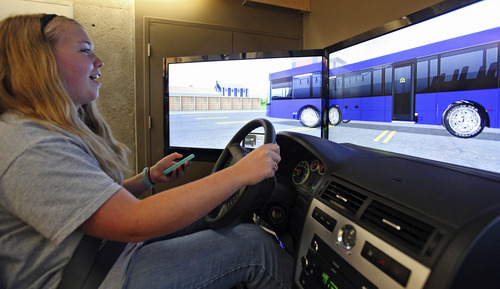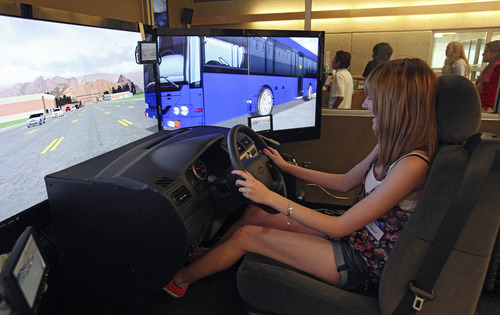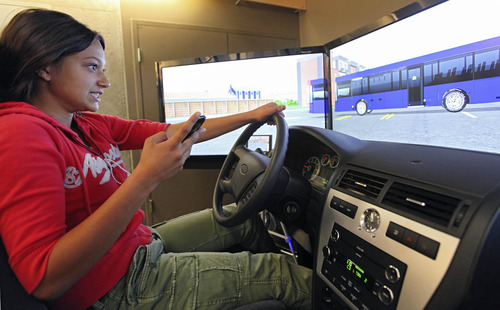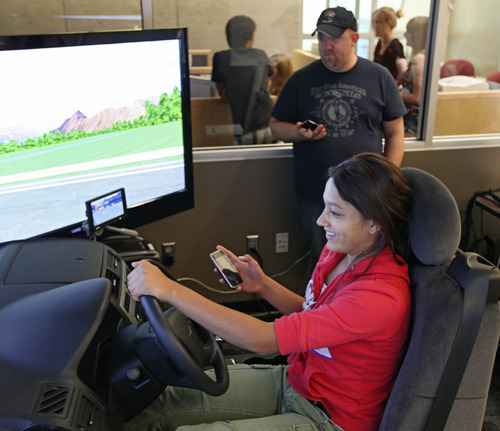This is an archived article that was published on sltrib.com in 2012, and information in the article may be outdated. It is provided only for personal research purposes and may not be reprinted.
William Cisneros is texting, talking on his phone and, yes, driving. Suddenly, a bus speeds into the intersection smack-dab in front of him. The 16-year-old slams on the brakes, but it's too late.
Cisneros laughs.
"This bus just came out, man," he says to his friend on the phone.
Cisneros can afford such a lighthearted reaction because, thankfully, the car he is driving and the bus he is ramming are not real. They are just simulations at the Utah Traffic Lab at the University of Utah.
Similar scenes played out time and time again Tuesday as high school students sideswiped, rear-ended and collided head-on with other vehicles — all part of a simulated effort to show the dangers of texting, talking or otherwise being distracted while behind the wheel.
Traffic crashes are the leading cause of death for U.S. teens, said R.J. Porter, professor of civil and environmental engineering at the U., citing distracted driving as a major factor.
Porter also pointed to a 2009 Pew Research Center study that found one in three texting teens ages 16 to 17 said they have texted while driving. Half of cellphone-owning teens ages 16 to 17 said they have talked on a phone while behind the wheel.
But out on the real roads, Cisneros doesn't text and drive. The Judge Memorial Catholic High School student has had his license since April and says it is a family rule: If you're driving, your phone goes in the glove box.
The traffic lab, with access to about 250 24-hour traffic cameras throughout the Salt Lake Valley, is a mini replica of the Utah Department of Transportation's control center. It is used not only to train students, but also UDOT employees.
At the end of the day, the distracted drivers were involved in four times more "virtual crashes" than the undistracted, said Milan Zlatkovic, the civil engineering researcher behind the simulation.
"They did not respond on time," Zlatkovic said, "or did not respond at all."
When they responded, reaction times were about 30 to 100 percent (1-3 seconds) slower than under normal conditions.
Although this was not a full-scale study, Zlatkovic said, this much is certain: "If the call or message you receive while driving is not a matter of life and death, it will become so the moment you answer it."
Educating students about distracted driving was not the only goal. The U.'s three-day BIO-Innovation camp also gave the 46 students a "little exposure" to various fields of engineering.
Erin Jepperson, a civil and environmental undergraduate student who helped run the camp, said she knew she wanted to pursue engineering but wasn't sure what type. Attending a camp like this one helps such students decide — all the while focusing on the fun side of engineering.
Besides driving the simulator, students learned about civil engineering by testing driving speeds on campus with radar guns. They learned about computer engineering by seeing how to operate their iPods with lasers. They sampled biomedical engineering by creating their own artificial-heart valves. And they designed a simplified human circulatory system via chemical engineering.
"You can do a bunch of different things," said Laura Medina, a civil engineering undergrad.



